
20 minute read
Modified Fatty Acids as Alternative Soap Thickeners
Modified Fatty Acids as Alternative Soap Thickeners for Lubricating Greases
By: Devin Granger, PhD and Shadaab Maghrabi, PhD Ingevity Corporation, Charleston, SC USA
Abstract
In 2020 and 2021, the COVID-19 pandemic has highlighted the fragility of global supply chains. Port closures in supply hubs have the potential to disrupt the 12-hydroxystearic acid (12-HSA) supply chain due to the vast majority of the supply used for grease thickeners passing through these hubs.[1] The introduction of effective alternatives to 12-HSA for use as grease thickeners can help grease manufacturers by alleviating their dependence on imports and reducing the possibility of production disruptions caused by supply chain breakdowns.
This paper describes initial experimental results that indicate that modified fatty acids (MFAs) not derived from castor oil can be used to form thickeners that are shear stable. The developmental MFAs can be used as obtained or blended with other fatty acids to form grease thickeners. Lithium soaps of the developmental MFA mixtures were used to produce greases with texture similar to that of reference lithium 12-HSA greases formulated with the same base oil. Although a slightly higher thickener percentage may be required in the developmental MFA formulations to obtain the same consistency as the reference greases, both types of greases exhibited similar shear stability as measured by prolonged working of 10,000 and 100,000 strokes in a mechanical grease worker.
The thickener efficiency of developmental MFA greases was nearly identical to that of reference lithium complex formulations (12-HSA and azelaic acid complex lithium soap). Worked penetration measurements of developmental MFA greases were comparable to the reference lithium complex formulations. These MFA-thickened greases were also evaluated for rheological characteristics, roll stability, oil bleed and dropping point, then compared to standard lithium 12-HSA and lithium complex formulations produced inhouse with the same base oil.
Introduction
For the past 70 years, 12-HSA has been the dominant fatty acid used for lithium soap thickeners in lubricating greases, and today, lithium soap greases make up more than 70% of the commercially available greases.[2] Greases produced from 12-HSA tend to have smooth texture and good thixotropic properties. A prior investigation into alternatives to 12-HSA as a thickener found that to a large degree, other stearic acid derivatives were not as well suited for grease use.[3] In most cases, the thickener efficiency of alternative fatty acids was very low compared to that of 12-HSA, requiring a larger concentration of thickener to achieve the same consistency of grease. Many of the other properties of the experimental greases, including shear stability, were inferior to those of lithium greases. Complexing dicarboxylic acids are used in small portions in lubricating grease formulations to improve high temperature tolerance. Commonly used dicarboxylic acids are typically produced from oleochemicals such as oleic and ricinoleic acids by a small number of sources.[4] Some long-chain dicarboxylic acid derivatives of fatty acids were investigated as co-thickeners in lithium soap lubricating greases.[5] These dicarboxylic acids performed comparably to standard complexing acids, e.g., azelaic acid, in lubricating grease formulations.
Even though there has been enough 12-HSA to meet grease production demand, recent shipping disruptions and potential port closures have highlighted the fragility of this supply chain that relies on sources from one region, South Asia.[1] This paper revisits the idea of alternatives to 12-HSA, focusing on fatty acid derivatives as potential thickener precursors. Modified fatty acid 1 (MFA1) and modified fatty acid 2 (MFA2) are used as obtained and blended with a fatty acid for use as a grease thickener. Lithium soaps are the focus of this investigation, because 12-HSA is widely used for lithium soaps, and lithium soaps are the most widely adopted grease technology.
Experimental Materials:
Base oils and chemical reagents were used as received. 12-HSA acid was purchased from Tokyo Chemical Industry (TCI) America (Portland, OR). Azelaic acid was purchased from Sigma-Aldrich (Burlington, MA). Lithium hydroxide monohydrate was purchased from Oakwood Products, Inc. (Estill, SC). The MFAs were developmental products produced at Ingevity.
Equipment
Soap reactions to form lithium greases were conducted on the bench scale using a standard glass kettle (Hammett Glass, North Augusta, SC) housed in a heating mantle (VWR, Radnor, PA) [Figure 1]. The reaction temperature was monitored with a K-type thermocouple attached to a programmable controller (J-KEM Scientific, St. Louis, MO). The reaction was agitated with a tilted disk impeller with alternating angled teeth (IKA Works Inc., Wilmington, NC). A nitrogen blanket delivered via sparging tube was used to avoid flashing of the base oil or other components and facilitate the removal of reaction water through a Dean Stark apparatus.
Figure 1: Processing equipment for grease sample production: (left) kettle-style chemical reactor and peripherals with mechanical overhead stirrer, and (right) 3-roll mill.
The grease samples were milled on a 3-roll mill (Exakt Technologies Inc., Oklahoma City, OK) [Figure 1]. Each sample was passed through the mill 3 times with manual mixing between passes to ensure homogeneity. The grease penetration was determined using a digital manual penetrometer (Humboldt Mfg. Co., Elgin, IL) [Figure 2a] per ASTM D217. If grease penetration was less than the target value, then the grease was diluted with base oil and remixed in the glass kettle with an anchor shaped impeller. The penetration was remeasured, and the process repeated until the desired penetration range was achieved.
Finished samples were shear tested by two methods. Method 1 employed a mechanical grease worker (Koehler Instrument Co. Inc., Holtsville, NY) [Figure 2b] to shear the sample, followed by the standard penetration measurement (ASTM D217). Method 2 used a roll stability cell with a 5 kg internal pin (Linetronic Technologies SA, Mendrisio, Switzerland) [Figure 2c] turned in a roller oven (ASTM D1831), followed by penetration measurements using the ¼-scale penetration method (ASTM D1403). Dropping point temperature was measured according to ASTM D566 using a stirred hot bath with thermometer and sample insert (Koehler Instrument Co. Inc.) [Figure 2d]. Oil separation was measured according to ASTM D6184 using a mesh cone suspended from a steel plate on a beaker (Koehler Instrument Co. Inc.) [Figure 2e]. Rheology and viscoelastic properties were measured according to DIN 51810-2 using a modular compact rheometer (Anton Paar USA Inc., Ashland, VA) with a 50 mm parallel plate geometry [Figure 3] and a 0.5 mm gap at 40°C.
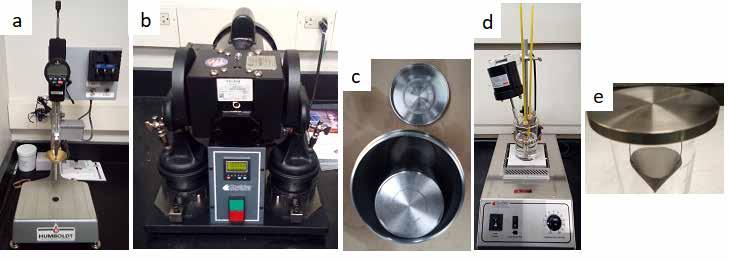
Figure 2: Standard grease testing apparatus: (a) electronic manual penetrometer, (b) mechanical grease worker, (c) roll stability testing cell, (d) dropping point apparatus, and (e) oil separation test apparatus.
Figure 3: Modular compact rheometer (left) and full instrument profile (right) sample stage with a 50 mm parallel plate geometry.
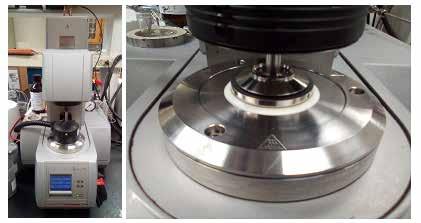
Personal Protective Equipment
Fume hoods were utilized as engineering controls for all work at high temperatures discussed above, including formulation of grease samples in the glass reactor and dropping point tests. The 3-roll mill was equipped with various safety shut-off devices and safety guards for safe usage. Safety glasses, laboratory coats and chemically resistant gloves were always used when handling raw materials and greases. Heatresistant gloves were used in addition to chemically resistant gloves when handling hot equipment.
Formulation
In this study, greases were formulated from only soaps and base oils, without any performance additives. Percent thickener was calculated from the combined masses of fatty acid and lithium hydroxide monohydrate divided by the total mass of grease components. The initial base oil and fatty acid were charged to the reaction kettle, heated and stirred under a N2 blanket.[Figure 4] The kettle contents were heated to 72°C until all fatty acid was completely dissolved in the base oil. If the fatty acid would not dissolve in the given base oil, the temperature was increased by 5°C increments until solvation occurred. A slurry of lithium hydroxide monohydrate in water (2x the mass of LiOH.H2O) was added to the kettle and the temperature profile shown in Figure 4 was followed. Once the sample temperature was below the flashpoint of the base oil, the quench oil was added to further cool the grease.
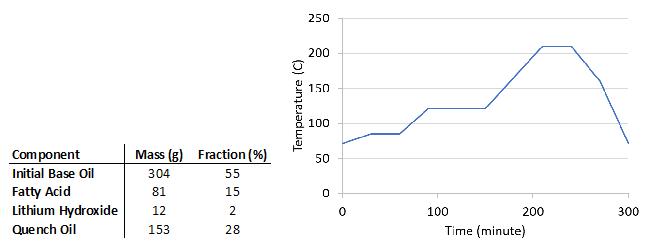
Figure 4: (left) Example formulation of 12-HSA grease, and (right) temperature ramp profile for soap reactions.
Results and Discussion
MFAs were tested against 12-HSA and 12-HSA/azelaic acid mixtures in the same base oil. We used two types of naphthenic base oils (NBO1 and NBO2) and two types of paraffinic base oils (G1BO and G2BO) in the study. The investigation started with the two naphthenic base oils; 1. NBO1 was International Standards Organization viscosity grade (ISO VG) 22 and NBO2 was ISO VG 220. 2. G1BO and G2BO were both ISO VG 22.
Instead of a specific thickener concentration, we targeted a penetration range (in units of 0.1 mm) for the resultant greases. We intended to produce grease samples with similar physical properties, allowing thickener efficiency to be determined in each base oil.
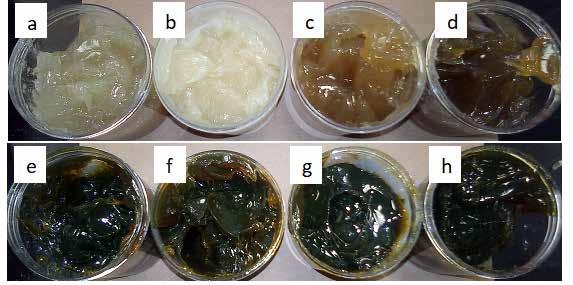
Figure 5: Grease samples using (top) NBO1 with (a) 12-HSA, (b) 12-HSA with azelaic acid, (c) MFA1, and (d) MFA2, and (bottom) NBO2 with (e) 12-HSA, (f) 12-HSA with azelaic acid, (g) MFA1, and (h) MFA2.
The MFA greases were very similar to the 12-HSA greases in appearance and texture, although the MFA greases were darker in color compared to the 12-HSA greases [Figure 5]. MFA1 produced similar grease properties to 12-HSA greases in both base oils at similar thickener concentrations [Table 1], suggesting that thickener efficiency was comparable for MFA1 and 12-HSA formulations in these base oils. MFA2 required considerably more thickener to achieve similar penetration measurements versus 12-HSA in both base oils. Oil bleed for greases prepared using naphthenic base oils was less than 1%. MFA thickened greases had lower dropping points compared to 12-HSA thickened greases.

Table 1: Thickener concentration of grease formulations with unworked penetration and NLGI grade, dropping point and oil bleed measurements in naphthenic base oil NB01 (left) NBO1 and NB02 (right). In NB01, the thickener concentration of 12-HSA + azelaic acid was 13% total with 11% from 12-HSA and 2% from azelaic acid. In NBO2, he thickener concentration of 12-HSA + azelaic acid was 8% total with 7% from 12-HSA and 1% from azelaic acid.
Worked penetration measurements of MFA1-thickened greases in both NBO1 and NBO2 showed slightly more shear softening compared to 12-HSA-based greases in the same base oils [Table 2]. The effect was more pronounced with NBO1 where an additional 9% difference was observed for the MFA1-thickened grease compared to the 12-HSA grease. MFA2 behaved differently than MFA1 in the naphthenic base oils, where MFA2-thickened greases were more shear stable under mechanical grease worker conditions compared to their 12-HSA grease counterparts. MFA2-thickened greases had only an 11% difference in penetration between 60 and 100,000 strokes, compared to 25% for 12-HSA greases. MFA2-thickened greases made in NBO1 stiffened under shear, while those formulated in NBO2 softened under shear.

Table 2: Worked penetration of grease formulations in naphthenic base oils, (left) NBO1, and (right) NBO2. Samples were worked using a mechanical grease worker, and penetration was measured using an electronic manual penetrometer (ASTM D217).
The difference in shear stability for greases formulated in naphthenic base oils was more pronounced after roll stability testing (ASTM D1831). Samples were rolled for 16 hours at 25 rpm using a standard roller cell with a 5 kg internal pin. The results of rolling NBO1 samples were analogous to the effects of using the mechanical grease worker [Table 3], though the MFA1-thickened greases softened more due to rolling than working. All NBO1 samples were negatively affected to a considerable extent by the addition of 10% water to the rolling cell, but MFA2-thickened greases performed much better than all other samples under this condition with only a 25% difference in penetration before and after rolling. The structure of the grease thickener broke down for greases formulated with MFA1 in both naphthenic base oils and for MFA2 in NBO2, while the 12-HSA thickener performed better in NBO2 then NBO1.

Table 3: Roll stability testing of grease formulations in naphthenic base oils, (left) NBO1, and (right) NBO2. Samples were rolled in a sealed steel cylinder with 5 kg internal steel pin (ASTM D1831), and penetration was measured using a ¼-scale cone (ASTM D1403).
Performance in Paraffinic Base Oils
Two paraffinic base oils were used to formulate greases, a Group I (G1BO) ISO VG 22 and a Group II (G2BO) ISO VG 22. Only MFA1 and 12-HSA thickeners were tested in both paraffinic oils; a blend of 12HSA and azelaic acid was also formulated in G1BO. The appearance and texture of these greases were very similar to that of the greases formed in NBO1, and MFA1 greases were very similar to 12-HSA greases in both paraffinic base oils [Figure 6], although the MFA1 greases were amber compared to the off-white 12HSA greases.
Figure 6: Grease samples formulated using (left) G1BO with (a) 12-HSA, (b) 12-HSA with azelaic acid, and (c) MFA1, and (right) G2BO with (d) 12-HSA, and (e) MFA1.

In G1BO, almost equal concentrations of MFA1 thickener and 12-HSA thickener were used to achieve greases with similar consistencies [Table 4] much like the performance of these thickeners in naphthenic base oils. However, in G2BO, MFA1 had considerably lower thickener efficiency than 12-HSA. The dropping point was depressed in the paraffinic base oils versus 12-HSA, with approximately a 20°C lower dropping point observed for MFA1 greases, which was consistent with the results for the greases prepared in naphthenic base oils. Oil bleed was similar for all samples, and values were typically between 1% and 3%, which was slightly higher than the naphthenic grease examples where the typical oil bleed was <1%.
Worked penetration results for greases prepared in paraffinic base oils showed some parallels with the results for the greases formulated in the naphthenic base oils. The greases prepared with MFA1 thickener showed better shear stability at 10,000 and 100,000 double strokes compared to both 12-HSA-thickened greases made in G1BO [Table 5 left]. MFA1-thickened grease demonstrated lower shear stability versus 12-HSA-thickened grease in G2BO at 10,000 double strokes, but similar stability at 100,000 double strokes [Table 5 right]. The penetration of the MFA1-thickened grease increased by 18% after 10,000 double strokes, but only up to 25% after 100,000 double strokes, whereas the 12-HSA-thickened grease increased by 10% and 22% after 10,000 and 100,000 double strokes, respectively.
Roll stability tests confirmed the results from the work stability tests when compared to the dry rolled samples [Table 6]. In G1BO, MFA1 and 12-HSA thickeners performed similarly when comparing percent change in penetration before and after the roll test. Similar changes in penetration were measured for worked and rolled samples of greases prepared with all thickeners in G2BO. Large differences in shear stability were observed for MFA1- versus 12-HSA-based greases when rolled with 10% water. The 12-HSAbased greases softened to grades 00 to 000 when water was introduced, while the MFA1-thickened greases softened (G1BO) or thickened (G2BO) by only 1 NLGI grade on rolling with water.

Table 4: Thickener concentration of grease formulations with unworked penetration and NLGI grade, dropping point and oil bleed measurements in paraffinic base oils (left) for G1BO. The thickener concentration of 12HSA + azelaic acid was 12% total with 10% from 12-HSA and 2% from azelaic acid. (right) for G2BO. 12-HSA and azelaic acid mix was not used in this comparison for G2BO.
Table 5: Worked penetration of grease formulations in paraffinic base oils, (left) G1BO, and (right) G2BO. The 12-HSA and azelaic acid blend was not used as comparison for G2BO. Samples were worked using a mechanical grease worker, and penetration was measured using an electronic penetrometer (ASTM D217).


Table 6: Roll stability testing of grease formulations in paraffinic base oils, (left) G1BO, and (right) G2BO. A blend of 12-HSA and azelaic acid was not used in this comparison for G2BO. Samples were rolled in a sealed steel cylinder with 5 kg internal steel pin (ASTM D1831), and penetration was measured using a ¼-scale cone (ASTM D1403).
Rheology Analysis
Rheological properties were measured for the grease samples formed in NBO1 and NBO2 [Figure 7] according to DIN 51810-2 Method A. The method requires a slow heat ramp to the desired test temperature (0.4°C/minute) and a long equilibration time at the test temperature (30 minutes). This procedure is due to the low thermal conductivity of grease, and insufficient temperature equilibration time can result in inconsistent results.
Rheology measures the physical response (glow and deformation) of materials under stress. Greases belong to a special subset of non-Newtonian viscoelastic materials.[6] An example of a rheology curve as measured by the rheometer [Figure 7 left] shows the linear viscoelastic (LVE) range where the storage modulus (G’) and loss modulus (G’’) remain relatively flat (constant) over a range of shear stresses. The G’ values were used to compare the consistency of the grease samples.[7] The G’ values within each base oil set were all very similar, which agreed well with the penetration measurements for these samples.

Figure 7: (left) Rheology data for greases thickened with MFA1 and lithium soap in NBO1. The storage modulus (G’, ---) and loss modulus (G’’, - - -) are shown on the same graph with both axes on a logarithmic scale. The values of G’ and G’’ intersect at the flow stress (τf) at which the sample becomes more liquid-like than solid-like and the shear stress where the linear viscoelastic region ends; G’ deviates more than 10% at the yield stress (τy). (right) Rheological values of G’ and τf for grease samples in NBO1 and NBO2.
The flow stress (τf) of the grease gives a measure of the sample behavior under shearing conditions. τf is the shear force required to effectively liquify the sample and is represented in rheology measurements as the point where the storage and loss moduli curves cross. Flow stress was consistently lower for MFA-thickened greases compared to 12-HSA-thickened greases, but not all thickeners had equivalent flow stress in both naphthenic base oils.
One of the most important properties of lubricating grease is its ability to shear thin and return to its solid state after shear is removed, thus keeping the lubricant in place. This behavior can be observed via a rheometer, allowing us to measure and compare the responses of greases. Each grease sample was conditioned in the same manner as DIN 51810-2, with a slow heating ramp followed by a long equilibration at constant. Samples were tested at 40°C using the oscillation mode of the rheometer by adjusting the shear strain to observe specific sample properties [Figure 8]. In stage 1, the shear strain was set to a value that was well within the LVE range for the sample (0.1% strain) to measure the baseline modulus. In stage 2, the shear strain was stepped up to a value well above τf for the sample (100% strain) in order to break down the solid structure. Then, in stage 3, the shear strain was set back to 0.1% to observe the regeneration of the solid structure of the sample.
Only the results for greases formulated with 12-HSA and MFA1 in NBO1 are is shown [Figure 8] for clarity. The 12-HSA- and MFA-based greases exhibited similar solid regeneration behavior. Both storage and loss moduli values were consistent with DIN 51810-2 measurements in stage 1 for all samples. During stage 2, the storage modulus dropped below the loss modulus as expected for grease sheared beyond its flow stress. When the high shear condition was stopped at the beginning of stage 3, the storage modulus increased strongly over the course of a few seconds, while the loss modulus fluctuated and eventually increased. Both moduli increased to below their initial values in stage 1 but continued to increase slowly over time. The initial recovery of the moduli was the same for both sets of samples, but in the MFAthickened greases, the moduli increased more quickly after the initial recovery than the 12-HSA-thickened greases. All samples fully regained their moduli after several hours.
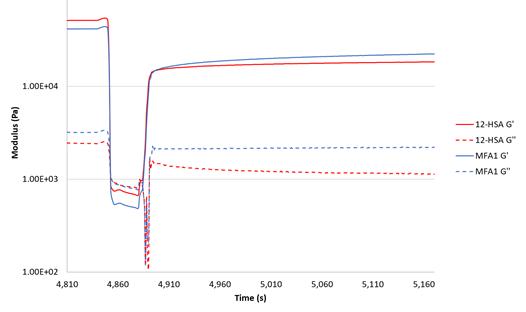
Figure 8: Thixotropic traces of greases formulated with 12-HSA (---) and MFA-1 (---) in NBO1. Low shear strain (0.1%) was used in stage 1 (4,810–4,850 s) to obtain baseline moduli; high shear strain (100%) was used in stage 2 (4,850–4,880 s) to break down the solid structure of the grease; and low shear was used in stage 3 (4,880 s and up) to observe rebuilding of the solid structure of the grease.
Conclusions
Soap thickened grease characteristics are often formulation dependent, and this behavior was observed in this study. Lithium soaps thickened with 12-HSA, 12-HSA complexed with azelaic acid and MFA soaps were prepared in two naphthenic base oils (ISO VG 22 and ISO VG 220) and two paraffinic base oils (Group I ISO VG 22 and Group II ISO VG 22). Greases were produced in a target penetration range (240 – 280 penetration units, 0.1 mm), and then dropping point, oil separation, shear stability and rheology were measured.
• Oil separation was similar for all samples in all base oils, but a small increase was observed for greases formulated with the Group II base oil. • The dropping points of the MFA-thickened greases were in the range of 180-190°C. • Results of mechanical working; o MFA1 greases shear thinned a little more, and MFA2 greases shear thinned less, than 12HSA greases in the naphthenic base oils. o MFA1 greases shear thinned a little less than 12-HSA greases in the Group I base oil, and but were similar in the Group II base oil. • Roll stability testing was similar for all the greases in the absence of water. • Roll stability testing in the presence of water produced severe negative effects on the greases tested with some exceptions: o MFA2-thickened greases in NBO1 were more shear stable than 12-HSA-thickened greases. o 12-HSA-thickened greases in NBO2 showed no difference in roll stability in the presence or absence of water. o MFA1-thickened greases in both paraffinic base oils demonstrated improved roll stability versus 12-HSA-thickened greases in the presence of water. o MFA1-thickened greases in both paraffinic base oils demonstrated improved roll stability in the presence of water versus dry conditions. • Rheology measurements showed that all tested greases had similar G’, but the MFA-thickened greases had lower flow stress values than the other greases. • Thixotropic measurements revealed that the MFA-thickened greases recovered their structure after shear degradation on the same time scale and magnitude as the 12-HSA-thickened greases. • The MFA greases had smooth and buttery texture that was similar to the texture typically observed for 12-HSA soap greases.
Although only NLGI grade 2 greases were studied here, a broad range of NLGI grades was achieved by varying the concentrations of the thickeners.
Acknowledgements
The authors thank the Ingevity Management for allowing us to publish this work in The NLGI Spokesman. We thank the Lubricants Technical Board and the Marketing and Communications Group for reviewing the manuscript. We would also like to thank NLGI for accepting our paper for presentation at the 2021 Annual Meeting and publishing our manuscript.
References
[] https://www.ilma.org/ILMA/ILMA/ILMA-News/2020/Castor_oil_derivatives.aspx [2] Grease Production Survey Report 2020, NLGI (www.NLGI.org) [3] Mould, W.R.; Silver, H.B. “An Investigation of the Thickening Properties of Substituted Lithium Stearates in Liquid Paraffin Base Oil” NLGI Spokesman, April 1976, 22. [4] Tuszynski, W.; Bessette, P.A. “An Evaluation of Sebacic Acid and Azelaic Acid as Thickeners in Lithium Complex Greases” NLGI Spokesman, 72 (4), 2008, 30. [5] Bertin, P.A.; Bessette, P.A. “Biorefinery-Derived Long Chain Dibasic Complexing Agents for Lithium Thickened Lubricating Greases” NLGI Spokesman, 79 (5), 2015, 24. [6] Chen, D.T.N.; Wen, Q.; Janmey, P.A.; Crocker, J.C.; Yodh, A.G. “Rheology of Soft Materials” Annual Reviews Condensed Mater Physics, 2010, 1, 301. [7] “What is Rheology and How Does It Relate to Industrial Lubricants?” Machinery Lubrication, https:// www.machinerylubrication.com/Read/31962/what-is-rheology-how-does-it-relate-to-industrial-lubricants




